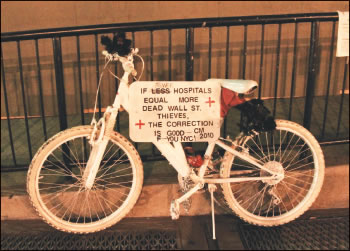By Lincoln Anderson
The opening of an urgent-care center in the former St. Vincent’s Hospital emergency department, though urgent, is being tied up in Bankruptcy Court. And if the delay lasts much longer, North Shore-Long Island Jewish Health System and Lenox Hill Hospital — which have been contracted by the state to operate the center — will start looking for a new location.
“We have every intention of getting in there, and we need six to eight weeks to renovate the space,” said Terry Lynam, a North Shore-L.I.J. spokesperson. “However, because of the delay in bankruptcy proceedings, we’re unable to get in there until we have a signed lease.”
North Shore-L.I.J. had hoped to have the facility up and running by August, but they still don’t have the lease, which needs to be signed with the Bankruptcy Court.
“We’re kind of in a holding pattern,” Lynam said. “We’re ready, willing and able, but because of the bankruptcy proceedings, we’re kind of hamstrung.
“We haven’t drawn a line in the sand, but if we continue to have delays much longer, we’ll have to look for an alternative site,” he said, adding they would try to find something in the Village. “We’re still committed to the project — it’s just a question of where. We got a $9.4 million grant [from the state] to establish the center. We have the staffing all planned, and are ready to move forward with equipping it. We’ve seen the space — they’ve given us access.”
Lynam said he couldn’t say why Bankruptcy Court is holding things up.
The urgent-care center would operate 24/7 and be able to accommodate 25,000 patient visits per year. There would be at least one ambulance on site to transport people to area hospitals in case they need a higher level of care.
The facility wouldn’t provide trauma care, such as for heart attacks, strokes or other serious illnesses, but rather would treat mild-to-moderate illnesses and injuries on an unscheduled, outpatient basis. If someone woke up in the middle of the night with a bad sore throat, for example, he or she could seek treatment at the urgent-care center.
Still hoping for hospital
Meanwhile, as the question of whether Greenwich Village will see the urgent-care facility open anytime soon, a debate raged at Community Board 2’s meeting two week ago over whether the community board would endorse “land locking” the St. Vincent’s property so that it can only be used as a hospital. There was also the question of whether there is even such a thing as “land locking” — but that didn’t stop people at the meeting from demanding that C.B. 2 endorse the idea.
About a half-dozen local residents testified during the meeting’s public session in favor of having the board back a purported land lock. Several of them – including Susan Howard, a well-known Lower East Side activist — also took shots at C.B. 2, saying the board had been unresponsive to the community.
Brad Hoylman, chairperson of the board’s St. Vincent’s Omnibus Committee, presented for the full board’s vote a resolution voicing C.B. 2’s “Support for the Continuation of Healthcare Services on the Former St. Vincent’s Campus.”
The resolution stated, in part, that the former St. Vincent’s Greenwich Village hospital campus is the “most logical, cost-effective and central location for the re-establishment of…a hospital or other healthcare facility that will adequately address the community’s myriad healthcare needs, and, in fact, may be the only location suitable for such a facility… . Therefore, be it resolved, that Community Board No. 2 strongly urges the U.S. Federal Bankruptcy Court, Governor Paterson, the State Department of Health and all of our elected representatives to do everything feasible within their powers to ensure that the successor healthcare entity to St. Vincent’s Hospital permanently remains on all or a portion of the former St. Vincent’s campus.”
‘It’s rhetorical’
Of the cries for the so-called land lock, Hoylman said, “I think that it’s a very well-intentioned call.” However, he then added, “It’s rhetorical — it doesn’t have much effect. … What are we ‘locking in’? We’re locking in a boarded-up building. Someone brought up the another example of a boarded-up building in our community — the Northern Dispensary,” he pointed out, referring to the historic former clinic building on Waverly Place.
St. Vincent’s was forced to close at the end of April, under a crushing debt of what turned out to be more than $1 billion. Now the former hospital’s creditors want their money back; the hospital’s real estate is its most valuable asset, and so is expected to be sold off for development.
In an interview with The Villager in June, Arthur Webb, St. Vincent’s former C.O.O., said that getting a new hospital in the Lower West Side area could someday become a reality — but he predicted, “That’s not going to happen in our lifetime.”
Resolution rage
As remote as the possibility of getting a new hospital may well be, that didn’t stop C.B. 2 from vigorously debating the resolution. Several board members openly criticized it. Tobi Bergman dubbed it “weak,” while Steve Ashkinazy termed it “extremely timid.”
“What’s wrong with toughening up our language — that we want a 21st-century hospital?” demanded Lisa Canistracci.
Jim Fouratt, who isn’t a C.B. 2 member, shouted out from the audience, “Where is [City Council Speaker] Chris Quinn? Why isn’t she here?” and kept on shouting, until he was gaveled quiet by Jo Hamilton, the board’s chairperson.
Calling the resolution “far too week,” C.B. 2 member Arthur Schwartz proposed what is known as a friendly amendment.
“Our goal is not to present a timid resolution,” Hoylman retorted, “but to present a responsible resolution, and show that we know what we’re talking about.”
Schwartz initially proposed adding the wording that C.B. 2 “opposes all changes in landmarks, zoning laws, etc. that would allow any other use than a hospital” at the St. Vincent’s site.
However, Hoylman called up to join him at the microphone David Reck, the board’s zoning expert, chairperson of the board’s Land Use and Business Development Committee (formerly known as the Zoning and Housing Committee). Reck explained that Schwartz’s amendment, as worded, would actually be asking for a zoning change of the St. Vincent’s site; currently, the property is zoned for community-use facility, which allows two different use groups, Reck noted, saying churches, for example, might currently be allowed.
“The zoning doesn’t only allow hospital use, so this amendment is not correct,” Hoylman noted of Schwartz’s proposal.
Resolution confusion
However, Schwartz explained, “Look — this is a political resolution, not a zoning resolution,” saying it was meant to send a message to local politicians.
A frustrated-sounding Florent Morellet stood up and complained of Schwartz’s “political resolution,” “I want us to be rational — this doesn’t make any sense.”
Bergman said that inserting Schwartz’s amendment — being written and revised on the fly — was creating a “hastily written resolution,” and said that it should be tabled, or held over till the next month’s meeting. Yet the board voted on the resolution, with Schwartz’s language added in, and it passed, 29 yes to 6 no, with 2 abstentions.
The wording of Schwartz’s friendly amendment — added onto the end of the board’s resolution as its conclusion — was “cleaned up” to read: “Therefore be it resolved that Community Board No. 2 opposes all changes in land use laws, zoning rules, landmarks laws or any other laws that would eliminate hospital uses at the site of the former St. Vincent’s Hospital, and…that C.B. 2 shall seek to petition the Bankruptcy Court and create a community committee to explore in a publicly transparent manner, all options for the St. Vincent’s campus, and requests assistance from the New York City Corporation Counsel [city Law Department] to assert such a petition, and…that C.B. 2 urges our elected officials to join C.B. 2 in this petition.”
Speaking after the meeting, Morellet again commented disapprovingly, “It became convoluted to change the resolution.”
With a wry smile, Ian Dutton, another C.B. 2 member, mused of the community board, “There’s lots of issues we face where we have to be responsible and there’s a screaming crowd — and, to a certain extent, we have to represent the screaming crowd.”
Knocks ‘land lock’
Also speaking afterward, C.B. 2 Chairperson Hamilton dismissed the concept of land locking property.
“No, there is no such thing,” she asserted. “You can’t just say that we will only accept a hospital there. The community board is not that powerful. The word ‘land lock’ is a made-up word — it’s a meaningless phrase. What we said is that we don’t want to see any changes to that land that would eliminate a hospital. We’ve always been on record for that.
“This [resolution] is just a reaffirmation that we are strongly in support of a hospital at that location — and have been for the last three years.
“Land cannot be locked for one specific use,” Hamilton reiterated. “I’m concerned that people’s expectations are being raised — that because of our resolution, people are thinking that only a hospital can be there.”
However, following the meeting, Yetta Kurland, a leader of the Coalition for a New Village Hospital, fired off an e-mail blast that read, in part: “WE PASSED THE RESOLUTION! That’s right, the board passed a resolution that put a land lock on the property to stop any changes to the zoning, certificate of occupancy or other part of the land use that would eliminate the hospital use. It also called on the Bankruptcy Court to be advised of this and to petition the court to set up a community council with the help of New York City Corporation Counsel to let the court know we want a hospital on the site of St. Vincent’s and to be engaged in the Bankruptcy Court’s procedures.” The e-mail concluded, “In solidarity, Yetta.”
‘Say what?’
Asked by The Villager about whether there is such a thing as a land lock, a Department of City Planning official first said she’d have to check, then responded later by e-mail: “We’re not familiar with the term ‘land lock’ in this context,” she said. “A restriction on as-of-right uses of private property other than a hospital would amount to a moratorium, and a moratorium in and of itself would require ULURP [uniform land use review procedure]. As of today, there are no applications concerning the disposition of St. Vincent’s property before City Planning — neither to rezone for additional development nor for a moratorium. While it is not possible to speculate on future proposals for the site, it’s worth noting that given the layers of regulations on this site, it is probable that any modification would come before City Planning and would require public input.”
Similarly, Reck noted that any rezoning of the St. Vincent’s site would come through C.B. 2 for review as part of ULURP.





































